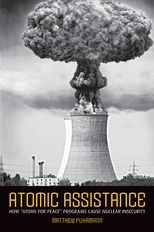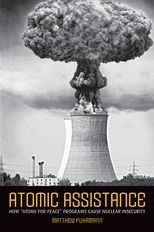Atomic Assistance: How "Atoms for Peace" Programs Cause Nuclear Insecurity
Atomic Assistance: How "Atoms for Peace" Programs Cause Nuclear Insecurity
Cite
Abstract
Nuclear technology is dual use in nature, meaning that it can be used to produce nuclear energy or to build nuclear weapons. Despite security concerns about proliferation, the United States and other nuclear nations have regularly shared with other countries nuclear technology, materials, and knowledge for peaceful purposes. This book argues that governments use peaceful nuclear assistance as a tool of economic statecraft. Nuclear suppliers hope that they can reap the benefits of foreign aid—improving relationships with their allies, limiting the influence of their adversaries, enhancing their energy security by gaining favorable access to oil supplies—without undermining their security. By providing peaceful nuclear assistance, however, countries inadvertently help spread nuclear weapons. This book draws on several cases of “Atoms for Peace,” including U.S. civilian nuclear assistance to Iran from 1957 to 1979; Soviet aid to Libya from 1975 to 1986; French, Italian, and Brazilian nuclear exports to Iraq from 1975 to 1981; and U.S. nuclear cooperation with India from 2001 to 2008. It also explores decision making in countries such as Japan, North Korea, Pakistan, South Africa, and Syria to determine why states began (or did not begin) nuclear weapons programs and why some programs succeeded while others failed. The book concludes that, on average, countries receiving higher levels of peaceful nuclear assistance are more likely to pursue and acquire the bomb—especially if they experience an international crisis after receiving aid.
-
Front Matter
-
Introduction: Unintended Consequences in International Politics
Matthew Fuhrmann
-
1
Definitions and Patterns of Peaceful Nuclear Cooperation
Matthew Fuhrmann
-
Part I Atoms for Peace
-
2
Economic Statecraft and Atoms for Peace: A Theory of Peaceful Nuclear Assistance
Matthew Fuhrmann
-
3
The Historical Record: A First Cut
Matthew Fuhrmann
-
4
Nuclear Arms and Influence: Assisting India, Iran, and Libya
Matthew Fuhrmann
-
5
A Thirst for Oil and Other Motives: Nine Puzzling Cases of Assistance
Matthew Fuhrmann
-
6
Oil for Peaceful Nuclear Assistance?
Matthew Fuhrmann
-
2
Economic Statecraft and Atoms for Peace: A Theory of Peaceful Nuclear Assistance
-
Part II Atoms for War
-
7
Spreading Temptation: Why Nuclear Export Strategies Backfire
Matthew Fuhrmann
-
8
Who Builds Bombs? How Peaceful Nuclear Cooperation Facilitates the Spread of Nuclear Weapons
Matthew Fuhrmann
-
9
Have International Institutions Made the World Safer?
Matthew Fuhrmann
-
Conclusion: What Peaceful Nuclear Assistance Teaches Us about International Relations
Matthew Fuhrmann
-
7
Spreading Temptation: Why Nuclear Export Strategies Backfire
-
End Matter
Sign in
Personal account
- Sign in with email/username & password
- Get email alerts
- Save searches
- Purchase content
- Activate your purchase/trial code
Institutional access
-
Sign in through your institution
- Sign in with a library card Sign in with username/password Recommend to your librarian
Institutional account management
Sign in as administratorPurchase
Our books are available by subscription or purchase to libraries and institutions.
Purchasing information| Month: | Total Views: |
|---|---|
| March 2023 | 3 |
| March 2023 | 3 |
| March 2023 | 3 |
| March 2023 | 3 |
| March 2023 | 3 |
| March 2023 | 4 |
| March 2023 | 3 |
| March 2023 | 3 |
| March 2023 | 3 |
| March 2023 | 3 |
| March 2023 | 3 |
| March 2023 | 3 |
| March 2023 | 3 |
| March 2023 | 3 |
| March 2023 | 3 |
| March 2023 | 3 |
| March 2023 | 3 |
| May 2023 | 1 |
| May 2023 | 2 |
| May 2023 | 1 |
| May 2023 | 1 |
| November 2023 | 1 |




Get help with access
Institutional access
Access to content on Oxford Academic is often provided through institutional subscriptions and purchases. If you are a member of an institution with an active account, you may be able to access content in one of the following ways:
IP based access
Typically, access is provided across an institutional network to a range of IP addresses. This authentication occurs automatically, and it is not possible to sign out of an IP authenticated account.
Sign in through your institution
Choose this option to get remote access when outside your institution. Shibboleth/Open Athens technology is used to provide single sign-on between your institution’s website and Oxford Academic.
If your institution is not listed or you cannot sign in to your institution’s website, please contact your librarian or administrator.
Sign in with a library card
Enter your library card number to sign in. If you cannot sign in, please contact your librarian.
Society Members
Society member access to a journal is achieved in one of the following ways:
Sign in through society site
Many societies offer single sign-on between the society website and Oxford Academic. If you see ‘Sign in through society site’ in the sign in pane within a journal:
If you do not have a society account or have forgotten your username or password, please contact your society.
Sign in using a personal account
Some societies use Oxford Academic personal accounts to provide access to their members. See below.
Personal account
A personal account can be used to get email alerts, save searches, purchase content, and activate subscriptions.
Some societies use Oxford Academic personal accounts to provide access to their members.
Viewing your signed in accounts
Click the account icon in the top right to:
Signed in but can't access content
Oxford Academic is home to a wide variety of products. The institutional subscription may not cover the content that you are trying to access. If you believe you should have access to that content, please contact your librarian.
Institutional account management
For librarians and administrators, your personal account also provides access to institutional account management. Here you will find options to view and activate subscriptions, manage institutional settings and access options, access usage statistics, and more.